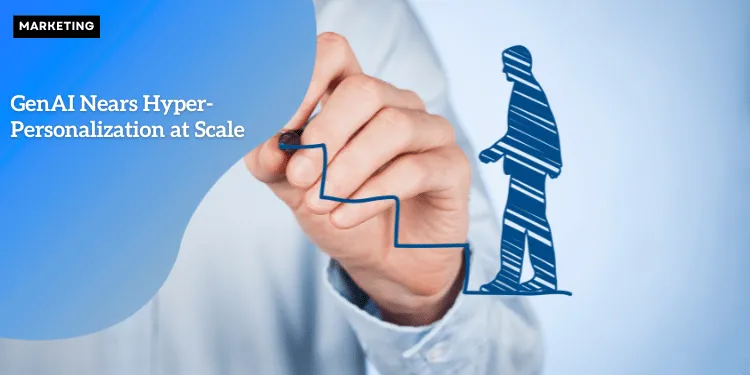GenAI Nears Hyper-Personalization at Scale

Anúncios
Introduction: The Evolution of Ecommerce Marketing and the Role of AI
For decades, ecommerce marketers have envisioned the ability to deliver the perfect marketing message to a specific shopper at precisely the right time, aiming to close a sale. Personalization has always been a key part of that vision.
As early as 20 years ago, marketers could set up rudimentary “business rules” — for example, “if this, then that” logic — or segment shoppers based on basic characteristics to deliver custom recommendations or messages.
While these methods helped drive some level of relevance, they were limited in scope, often labor-intensive, and didn’t always achieve the intended results.
Fast forward to today, and the emergence of generative artificial intelligence (GenAI) has radically expanded the possibilities of personalization.
Anúncios
By automating and scaling previously impractical tasks, GenAI allows marketers to craft hyper-personalized experiences that are more effective and efficient than ever before.

What is Hyper-Personalization?
Hyper-personalization is the next step in the evolution of personalized marketing.
Anúncios
It goes beyond the traditional tactics of segmentation and customization by leveraging real-time data and generative AI.
Hyper-personalization allows businesses to deliver highly tailored marketing messages, product recommendations, and offers to individual shoppers at scale — often in real-time.
This is made possible by combining massive amounts of data with advanced AI algorithms that can analyze shopper behavior, preferences, and even predictive trends.
The result is a personalized experience that feels highly relevant to each customer, increasing engagement and the likelihood of conversion.
Imagine this: a marketing team creates an outline that includes the company’s key selling points, brand differentiators, and tone of voice.
Then, AI takes this framework and generates unique, optimized messages for each shopper, factoring in their individual preferences, behaviors, and past interactions with the brand.
This form of automation allows companies to create personalized content and messaging at an unprecedented scale.
What makes this even more exciting is that these hyper-personalization tools are no longer reserved for large enterprises.
Thanks to the rapid development of AI technology, even small and mid-sized businesses (SMBs) can now access tools that allow them to deliver tailored, scalable messaging.
Solving Core Problems with Hyper-Personalization
While hyper-personalization is an exciting development for ecommerce marketers, it does come with several challenges.
These challenges have historically made it difficult to achieve personalized marketing at scale.
Let’s examine three key problems that have been addressed by the latest generative AI platforms.
1. Data Capture: The Foundation of Personalization
Effective hyper-personalization is only possible if marketers can capture the right data.
To deliver messages that resonate with individual shoppers, businesses need access to vast amounts of data, including:
-
📊 Shopper demographics
-
🔍 Behavioral insights (e.g., browsing habits, purchase history)
-
💡 Preferences and interests
-
📝 Customer feedback and sentiment
However, ecommerce marketing teams often struggle to collect and manage this data.
While many companies have access to first-party data from their own websites or third-party data providers, they may lack the technical expertise, resources, or time to leverage this data effectively.
This is where AI platforms like Backstroke come into play.
Backstroke is a generative AI email platform that integrates with popular ecommerce platforms like Klaviyo, making it easier for businesses to gather and process essential shopper data.
With this data at its disposal, Backstroke’s AI can generate personalized marketing emails that are tailored to the unique preferences of each customer.
Similarly, platforms like Blueshift integrate with Shopify and Magento, providing powerful data collection tools that enable marketers to make the most of the shopper data they already have.
The AI platforms allow businesses to capture and analyze shopper data in real-time, creating a more accurate picture of each shopper’s behavior, preferences, and buying intent.
2. Data Comprehension and Use: Organizing Shopper Profiles
Once data is captured, the next hurdle is understanding it and turning it into actionable insights.
This is where data comprehension becomes crucial. Many marketing teams struggle to use the data they collect effectively.
Manually segmenting shoppers into specific categories — such as age, gender, repeat customers, or lapsed buyers — can be time-consuming and inefficient.
AI platforms like Backstroke, Blueshift, and other generative AI tools are changing the game by automating this process.
These tools use advanced algorithms to group shoppers into highly specific segments based on a range of attributes.
As the AI continues to learn from the data, it refines these segments, continuously improving the accuracy of the profiles it creates.
Imagine an ecommerce lifecycle marketer manually managing 20 different segments and crafting individualized emails for each one.
The process is time-consuming and prone to human error.
However, AI can automatically generate hundreds of segments based on data and continuously optimize them, improving marketing accuracy and efficiency.
The result is that AI allows ecommerce marketers to deliver messages that are far more relevant to each shopper, based on their real-time actions and buying intent.
3. Content Creation: Overcoming the Complexity of Message Optimization
The third major challenge that has been addressed by generative AI is content creation.
Creating hyper-personalized content at scale can be a daunting task.
Consider an ecommerce marketer tasked with composing, testing, and optimizing a sequence of three emails for 10 different shopper segments.
That’s 30 emails to write, plus testing different subject lines, content variations, and CTAs. The sheer volume of emails quickly becomes overwhelming.
Generative AI platforms, however, can automate the entire content creation process.
Instead of manually writing 90 or even 900 versions of marketing emails, marketers can provide an AI framework with their desired tone, objectives, and key selling points.
The AI then generates the content — from subject lines to product recommendations — and continually optimizes the messaging for each recipient based on their data.
For SMBs, this level of automation makes it possible to scale personalization efforts without requiring a dedicated team of content creators or excessive resources.
Marketers can now focus on strategic decisions and high-level creative work, while AI handles the heavy lifting of content generation.
Generative AI for SMBs: A Game-Changer in Ecommerce
| Topic | Details |
|---|---|
| ⏳ Current State of Hyper-Personalization | As of October 2024, true hyper-personalization at scale remains a work in progress, but advancements in AI show promising signs. |
| 🤖 Role of Generative AI | Generative AI is paving the way for delivering hyper-personalized content, bringing powerful tools to even small ecommerce businesses. |
| 💡 Declining Costs of AI | The decreasing cost of AI technology is making it more accessible to a wider range of businesses, enhancing personalization at scale. |
As generative AI platforms become more affordable and accessible, SMBs can soon leverage these powerful tools to compete with larger competitors in a way that was previously unthinkable.
For example, small businesses that previously couldn’t afford the resources needed to execute personalized campaigns at scale will soon be able to access AI-powered tools that automate the process.
This democratization of AI technology means that even the smallest ecommerce companies can enhance their marketing capabilities and engage with customers on a highly personalized level.
The Road Ahead: Looking Toward the Future of Ecommerce Marketing
While full-scale hyper-personalization is not yet a reality, the growing capabilities of generative AI indicate that it is fast approaching.
As more businesses adopt AI-powered tools, the boundaries of personalization will continue to expand.
In the near future, AI will not only create hyper-personalized emails but will also assist in delivering personalized experiences across multiple channels — including text, chat, and even in-app interactions.
Moreover, as AI continues to learn and evolve, its ability to predict customer behavior and recommend personalized products, offers, and messages will become more precise, improving the overall effectiveness of ecommerce marketing campaigns.
For ecommerce marketers, the time to begin embracing generative AI and hyper-personalization is now.
As technology continues to evolve, businesses that adopt these tools early will be well-positioned to thrive in an increasingly competitive market.
Conclusion: Embracing the Future of Hyper-Personalization
The rise of generative AI marks a pivotal moment in the evolution of ecommerce marketing.
By enabling businesses to automate and scale the creation of hyper-personalized content, AI offers ecommerce brands an unprecedented opportunity to engage customers on a more personal and meaningful level.
As the cost of AI tools continues to decline and more businesses adopt these technologies, the future of personalized marketing is brighter than ever before.
The next frontier in ecommerce marketing is clear: hyper-personalization at scale, powered by generative AI.
And as this technology matures, the possibilities for enhanced customer experiences and higher conversion rates will continue to grow.
